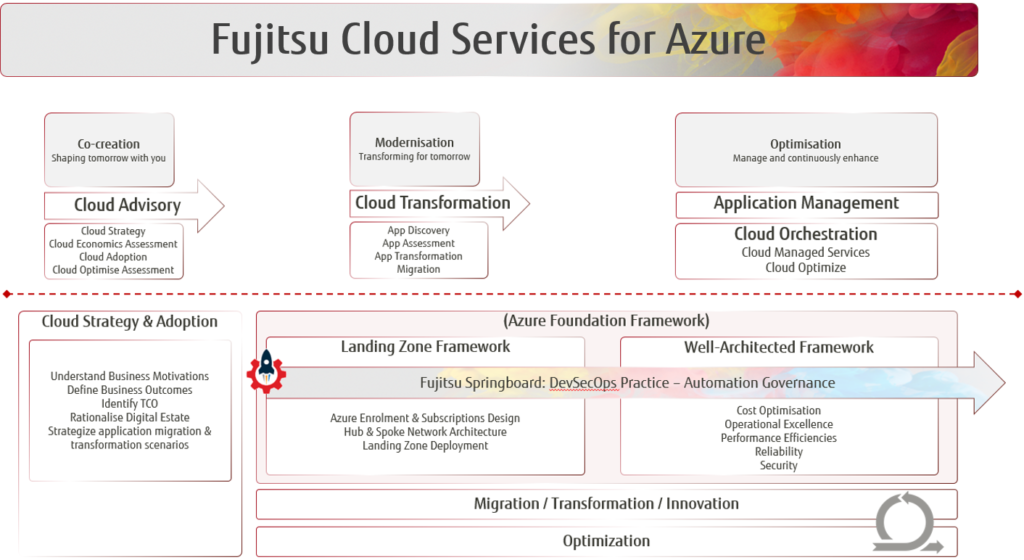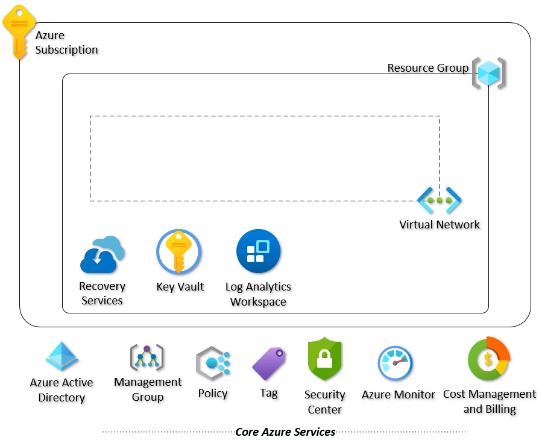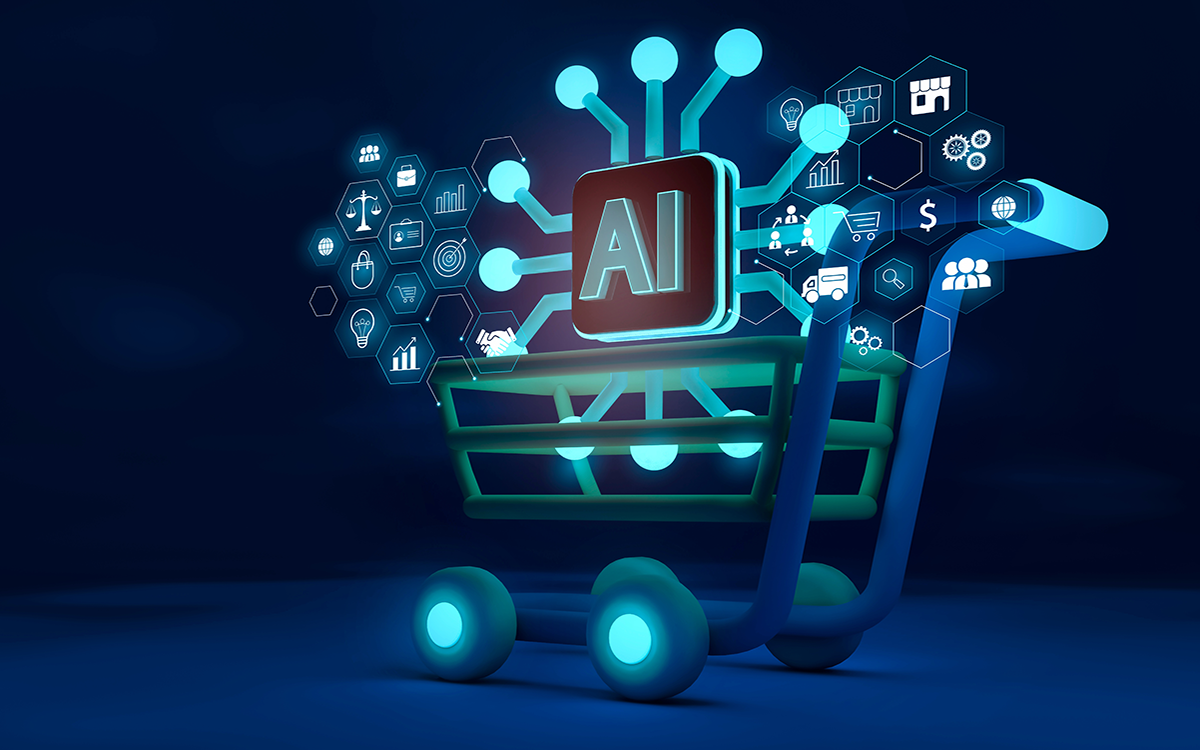
How many times have you heard the phrases CAF, Azure Scaffold, Landing Zone, Well-Architected Framework (WAF) etc. thrown around? Are you lost or confused, and unsure of what terms to use, when you should use them, and what they mean? Are you unsure of how important these elements are during different stages of Cloud adoption?
Well, let me take you through them and see if I can make it a little less cloudy...
Different cloud providers have their own Cloud Adoption Frameworks, here at Fujitsu we leverage the best of them all as part of the Fujitsu Your Cloud Framework. I’ll focus in on the Azure pathway for the rest of this article, so that we can get specific on the activities and considerations for cloud adoption with Azure.
Many organisations want to adopt cloud and may start consuming without proper planning or strategy in place. Or they may have a strategy, but consume it in a piecemeal fashion without an overall framework in place. Some organisations do not have insights into their digital estate, so they get overwhelmed when considering discovery and analysis, which hinders their adoption of cloud.
This may be due to the fact that they don't know where to start and what their business requirements are in adopting cloud. If they have passed this stage, then they may be oblivious on how to technically implement the Azure framework that covers network architecture to operational and management elements and most importantly the cloud skills required to execute and support the new environment.
In order to consume Azure, all you need is a subscription and a virtual network, allowing you to deploy or migrate virtual machines. For some of the PaaS services you may not even need to have a virtual network! This is where an organisation may make their first mistake as they rush to start consuming Azure with no guardrails in place or standards defined to enforce, creating bigger challenges down the track. Thus, leading into an arduous review and a clean-up activity.
So what is the Microsoft Cloud Adoption Framework (CAF), why is it a critical success factor for an organisation adopting cloud, and how does it address these sorts of challenges?
According to Microsoft, their cloud adoption framework "is a collection of documentation, implementation guidance, best practices, and tools that are proven guidance from Microsoft designed to accelerate your cloud adoption journey."
Using these guidelines and best practice, Fujitsu has created our Your Cloud Framework and our standard Reference Architecture, which underpin the Fujitsu Cloud Service for Azure. This is Fujitsu’s end to end service for the adoption and ongoing management and optimisation of your Azure services. Our optimisation is not limited to your estate either, we continually optimise our cloud framework, our reference architecture and our automation library to the betterment of all of our customers.
So if the Cloud Adoption Framework is a key ingredient in cloud success, let’s break it down to understand it better. Let’s start with the three key pillars of the Cloud Adoption Framework:
1. Cloud Strategy and Adoption
This pillar is key to understand business objectives, motivations, and reasoning behind adopting cloud such as Data Centre exits, Application Transformation, Security, Disaster Recovery and more!
The next natural step is to prepare a business case via a Cloud Economics assessment - identifying the Total Cost of Ownership (TCO) and ROI Return on Investment (ROI) to adopt cloud through discovery, assessment and financial modelling, using current state cost with future state costs (covering IT and business cost and benefits). The discovered application estate data will be further rationalised in order to form a migration or transformation strategy with a prioritised backlog of activities which underpin your strategic business initiatives.
A good migration strategy is to batch the application workload in a group of tens (Power of 10). However, a transformation strategy will require a thorough program increment planning approach to re-architect/rebuild the application using cloud native using DevOps practice.
When it comes to deciding on the best strategy for your estate, you will need to go through an application strategy process, or a rationalisation process, to determine the best approach for migration or transformation of each of your business systems. Microsoft has published some myth busters, which you should be familiar with, as there are a number of common challenges and mistakes. There are some common myths around rationalisation that you need to be aware of.
When it comes to this stage of the process my advice to you is:
- Set your business goals at the outset of your adoption programme to ensure that all decisions are made in support of the business goals.
- Prioritise the transformation of your most critical business applications - the ones which have the highest touch with your user community and can influence revenue and customer perception.
- Iterate your adoption process - start with your quick wins to demonstrate value to your stakeholders, and then progress through your backlog in lock-step with your business priorities.
- Don’t suffer from analysis paralysis - make short, quick and early steps to prove your hypothesis and to ensure that early momentum is achieved and then maintained.
- Transparency is your best friend. Document all decisions, publish a wiki, and dedicate a perpetual chat-channel through your adoption programme for stakeholder communications. Essentially, you need to communicate regularly and hide nothing, that way you can benefit from collective wisdom and avoid missed false expectations.
The figure below shows how Fujitsu Cloud Services for Azure aligns to the CAF.

The next two pillars can be categorised as Azure Scaffolding or as I call it the “Azure foundation framework”. They are essentially a combination of Azure Landing Zone and a Well-Architected framework, covering all aspects of a highly performant and well designed cloud model, such as governance, compliance and management.
2. Azure Landing Zone

The Landing Zone essentially focuses on the design of your Hub and Spoke Network Architecture (using cloud-native and virtual Firewall appliance), and a baseline configuration of your subscriptions using cloud-native services such as Azure Management Group, RBAC model using AAD, Azure Policies, Tag, Monitor, Update Management, Backup/DR etc.
This provides a solid and secure network framework to deploy workloads, separate your core services from the application workload and other native security services, as well as an operational framework to enable and enforce guardrails providing governance, compliance and management of those workloads.
This architecture is flexible enough to scale for workloads from IaaS to PaaS and beyond, as well as allowing the customer to replace services as the technology changes.
3. Well-Architected Framework
The Well-Architected Framework, or “WAF” for short, essentially focuses on 5 key areas:
- Cost optimisation
- Performance efficiencies
- Reliability
- Security
- Operational excellence
It is a framework to ensure that any solution deployed within Azure…
- is secure by design.
- is reliable and resilient (such as HA, BCP/DR) by design leveraging mainly the cloud-native toolsets.
- is monitored to continuously improve on the performance of the solution deployed to avoid any potential failures to meet SLAs.
- is continually updated and enhanced with newer features and technologies that are released (using DevOps practice and CI/CD releases).
- is cost optimised either using automated scalability features and/or other cost-saving measure such as Reserved Instance, Azure Hybrid Use Benefits etc.
These two pillars of the framework can be built as a baseline (MVP - Minimal Viable Product) that is scalable and can be expanded on as business needs changes in the future, but at the same time provides a robust foundation framework allowing customers to migrate and transform applications.
It is so critical to consider and apply Well-Architected Framework when designing any application solution within Azure to ensure all aspects of the framework is covered during its design phase. This will allow you to enable, manage and maintain from cost, security and operational perspective during its life-cycle.
Last but not least, accelerate the adoption in a fast iterative agile way using DevOps practice to ensure your cloud platform services are enabled and maintained as technology architecture changes as well as workload and applications deployed, managed and maintained continuously with governance in place.
I’d love to hear from you about your cloud adoption journey and the lessons that you’ve learnt along the way. Equally, if you’ve
- Not yet started and need a Cloud Adoption Accelerator, or
- If you need a Cloud Adoption Assessment to health check your existing programme.
Please get in touch for any help you may need, I’d love to connect.












